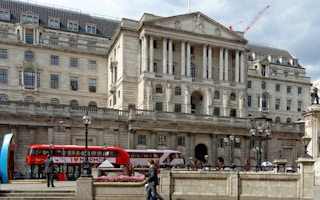Financial markets have yet to grasp the urgency of investing in measures to protect businesses and people from the worsening impacts of climate change, depriving those efforts of much-needed funds, climate finance experts said.
Samy Ben-Jaafar, director of the private sector facility at the Green Climate Fund (GCF), a new $10 billion fund agreed at UN climate talks, said the majority of companies were failing to protect their assets and supply chains from natural disasters and other climate-related risks because “there’s no penalty for not doing it”.
Central banks and credit rating agencies have yet to wake up to the need for commercial banks and corporations to test their exposure to climate change, he told the Thomson Reuters Foundation in an interview at a carbon market conference in Barcelona.
“No one is telling the chief financial officers and risk managers of these companies to pay attention to this, so it is being ignored,” he said.
Last month, Standard and Poor’s Ratings Services said the prospect of more frequent and severe climatic events would make the information companies disclose about their exposure to natural disasters more relevant to their credit rating in future.
Credit ratings affect how much a company must pay to borrow money from the capital markets.
“
When you speak of adaptation in a business setting, people’s eyes glaze over … but if you speak about business continuity and protecting supply chains, that resonates very well.
Mark Redwood, adaptation specialist, International Development Research Centre.
Since 2005, only around 60 of 6,300 downgrades of companies’ credit ratings were due mainly or materially to tropical storms, floods, droughts or earthquakes, the agency said.
But that kind of downgrade could become more widespread, it warned, noting the energy and consumer products sectors were most at risk.
In July, the Bank of England will submit to the British government a report on climate adaptation challenges to the insurance sector. Environmental changes could also affect the stability of the wider financial sector, with implications for central banks, it said in a recent discussion paper.
Despite these signs of a shift in mindset, Ben-Jaafar said the lack of interest in climate risk among central banks and ratings agencies so far meant companies that do act to protect themselves are not being rewarded.
He urged the Basel-based Bank for International Settlements - to which 60 central banks belong - to change the international rules so that central banks would require financial institutions to test their lending portfolios for climate change exposure.
“They could be mandated to do it tomorrow and, all of a sudden, adaptation will become front and centre,” he said.
Companies that have operations or supply chains that are at high risk of disruption from climate impacts should make a case for that shift, he added.
‘Eyes glaze over’
One problem he and other experts identified is that both government and non-governmental organisations working on adaptation to climate change do not know how to present it in a way that attracts the private sector.
“When you speak of adaptation in a business setting, people’s eyes glaze over … but if you speak about business continuity and protecting supply chains, that resonates very well,” said Mark Redwood, an adaptation specialist with the International Development Research Centre.
Increasingly, multinational food manufacturers and retailers are becoming aware that global warming threatens the commodities they buy - from coffee and cocoa to cereals - and are beginning to take steps to ensure their procurement around the world.
That could benefit small farmers in developing nations who produce raw materials but are being hit by shifting and erratic weather patterns, experts said.
Redwood suggested adaptation project planners should focus on agriculture and water because these are “fundamental sectors to the economies of many developing countries”.
There is also a need to come up with better project proposals that offer clear, long-term adaptation benefits and a high-enough financial return to attract private investment, he added.
The scarcity of appealing projects and the difficulty of measuring results partly explains why adaptation has received only a fraction of global climate finance flows in the past few years - just 7 percent in 2013, according to a report from Climate Policy Initiative, a research and advisory group.
The Green Climate Fund aims to rectify that imbalance, with a stated goal of spending half of its resources on adaptation projects.
Smita Nakhooda, a researcher with the London-based Overseas Development Institute who also advises the GCF, said the fund was looking to identify and support “good opportunities” around adaptation in the poorest and most vulnerable countries.
It is seeking to make a difference in areas such as food, health and water security, as well as infrastructure development, she added.
Spending half its resources on adaptation would be a “conscious challenge” for the fund, she noted.
But she pointed to the first batch of partners it has chosen to work with, including organisations in the Pacific region, Senegal and Peru that have substantial experience of environmental protection and sustainable development.
“The new range of partnerships through which the fund is able to work is going to help it take a new and inventive approach to adaptation,” she said.

















